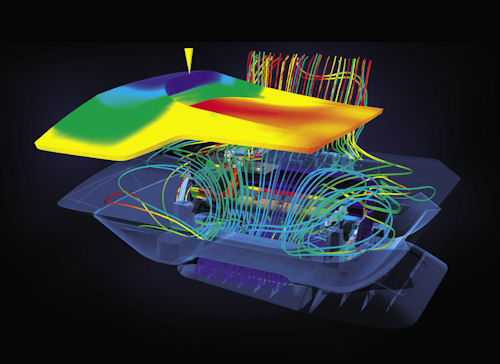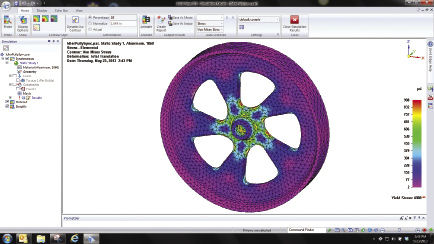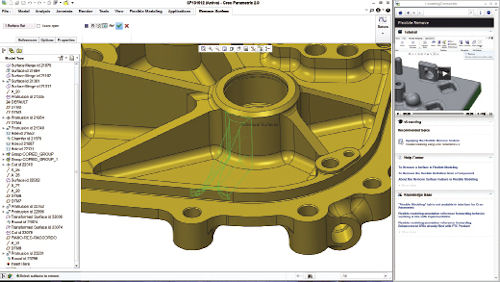Latest News
July 1, 2013
 This analysis of a desktop printer uses different software packages in the Autodesk Simulation 360 family. The image shows mechanical stress (color regions on the ink-jet cartridge holders), Moldflow injection pressure (visible as colors on the top section of the printer), and fluid and thermal simulation (streamlines throughout). Image courtesy of Autodesk. |
Well, it’s time to think again. Companies developing software for analyzing mechanical and/or fluid designs are scrambling to get a piece of the SMB action—and that’s paying off to your benefit. They now offer manageable simulation tools that work when your budget is modest (some well below $15,000) and when your analysis “staff” is also responsible for CAD, soldering and printer repair.
DE challenged a number of companies plus a university to detail just what they’re doing to make such simulations intuitive, flexible and affordable for non-experts. In Part 1, we’ll focus on simulation embedded in CAD software.
More than Just Technically Useful
Since working in one’s everyday CAD environment provides a natural comfort zone, it’s no wonder that CAD packages with embedded simulation functions have great appeal for many product designers. SolidWorks, Autodesk, PTC and Siemens PLM Software Solid Edge products come to mind.
Delphine Genouvrier, SolidWorks senior product manager, says, “The SolidWorks Simulation solution is fully embedded in SolidWorks 3D CAD, which means product engineers keep using the same interface, product philosophy, familiar workflow and commands when designing and testing a design. This shortens the learning curve.” It also means that the 3D CAD model becomes the simulation model without any data translation.
With this single interface, the family of SolidWorks Simulation solutions generates consistent and coupled results. For example, thermal computational fluid dynamics (CFD) results from SolidWorks Flow Simulation can be used as direct input for a large displacement structural simulation in SolidWorks Simulation Premium. As customer needs evolve, users can easily add SolidWorks Plastics for plastic injection simulation (parts and molds), SolidWorks Motion (rigid body dynamic simulation), and SolidWorks Sustainability (for sustainable design testing).
From an engineering design standpoint, SMBs have always been a sweet spot for Autodesk, says Luke Mihelcic, simulation product marketing executive. “We’ve taken Inventor (3D design) tools and added internal basic functionality to give users a taste of simulation,” he says. Outside of Inventor, the company’s Autodesk Simulation products run the gamut, from Mechanical and CFD to several versions of Moldflow for parts or assemblies.
Mihelcic adds that what’s exciting about making simulation accessible to SMBs are the new Autodesk 360 packages. These take the various desktop products and put them in cloud-based bundles, with a one-year license allowing 120 simulations at greatly reduced prices compared to the standard price structure. For example, Autodesk Simulation 360 Professional bundles Autodesk Mechanical, CFD and Robot Structure Analysis, all for $3,600. The software has full function capabilities—plus, users can buy more simulation runs as needed beyond the 120. Plans are underway for even shorter term licensing models for companies that frequently handle projects where simulations are only run for two to three months’ time.
 Stress results from FEA of an idler pulley, performed within SolidEdge from Siemens PLM Software. Image courtesy Siemens PLM Software. |
Autodesk is also on the cutting edge of mobile apps for simulation and using wiki sites for on-demand training. The company offers Autodesk ForceEffect and ForceEffect Motion (to quickly get an idea of the forces in a new design) for free on IOS and Android platforms, downloadable through the Google Chrome Web Store. Both apps have been out for about a year-and-a-half, and have seen more than 500,000 downloads. Autodesk’s community-enhanced WikiHelp pages step design engineers through Quick Starts, Essential Skills, Tutorials and more—all free and all conveniently accessible on the user’s schedule.
PTC’s goal has always been to put good structural analysis tools at the fingertips of the desktop engineer—tools that don’t require the expertise of a full-time finite element analysis (FEA) expert. Brian Thompson, PTC vice president of product management, notes, for example, that the company’s meshing approach uses P elements instead of typical H elements. Because these inherently map well to the geometry, mesh density is not a huge issue; the meshing algorithms don’t require multiple passes for optimization, making the whole process easier.
Thompson says, “More recently, we’ve done some special work to improve adoption and use of our analysis tools for the individual user, completely revamping the user experience. If you look at the PTC Creo Simulate extension, you see a very modern, ribbon-based interface with grouped commands. Also, even without the extension, you actually get a free wizard-based analysis tool with a check-box approach that steps you through the process, limited only by the size of the model.”
Other improvements in the PTC Creo Simulate extension include easier software installation, easier bolted-joint idealization, and a simplified way to analyze non-linear problems. For the last, if you have experimental force-vs.-deflection data for a non-linear material, the software will fit a curve to the data and automatically apply it to a given design model. It’s a powerful aid to someone just getting started with such problems.
 PTC Creo Flexible Modeling Extension with PTC LearningConnector gives SMB customers seamless access to an eLearning library, online help and the PTC KnowledgeBase in a context-sensitive way to find exactly the information needed to be efficiently productive. The PTC LearningConnector is a free learning application that comes with PTC Creo, PTC Windchill, PTC Mathcad Prime and PTC Arbortext software. Image courtesy of PTC. |
Solid Edge 3D CAD design software, a core component of the Siemens PLM Velocity Series portfolio, includes analysis capabilities that complement those of Femap, the company’s specialist software. In fact, Solid Edge Simulation employs Femap for meshing and Seimens PLM NX NASTRAN for solving, but makes it all easier for the mainstream engineer. For example, employing the philosophy of the CAD system—using synchronous technology to edit designs faster—a given material choice not only assigns a color for the CAD image, but also all material properties for mechanical simulation.
Bill McClure, vice president of product development for Solid Edge, Siemens PLM Software, explains that the software also guides users through an analysis by automatically recognizing and applying relevant tasks such as creating a mid-plane on sheet metal, a solid mesh on a solid part and a beam mesh on a beam.
Thermal analysis capabilities were added to Solid Edge in version ST5, and optimization has been added in the recent release of Solid Edge ST6. In other news, Solid Edge plans to launch an online store later this summer where customers can purchase and download the software for use on a monthly subscription basis. McClure notes that the new subscription model is expected to appeal to SMBs, particularly those who are looking for more affordable and flexible alternatives to traditional, professional CAD offerings.
In Part 2 of this article, we’ll look at how other companies are connecting CAD with simulation, making computational fluid dynamics (CFD) accessible, and providing training.
Contributing Editor Pamela Waterman, DE’s simulation expert, is an electrical engineer and freelance technical writer based in Arizona. You can send her e-mail to [email protected].
More info
Subscribe to our FREE magazine, FREE email newsletters or both!
Latest News
About the Author
Pamela Waterman worked as Digital Engineering’s contributing editor for two decades. Contact her via .(JavaScript must be enabled to view this email address).
Follow DE





